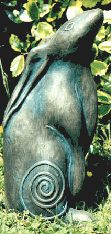Saturday, March 30, 2013
Eostre at Spring Equinox
Image: Wendy Andrew.
See also the previous posts:
Eostre – Goddess of New Life Beginnings
The Easter Hare
Remembering Eostre
Celebrating Eostre
The Goddess Ostara
Sacred
Thursday, March 21, 2013
Monday, March 18, 2013
"A Cipher for Unsullied Natural Wildness and Vitality"
 Writes Simon Carnell in Hare . . .
Writes Simon Carnell in Hare . . .When W. B. Yeats wrote of staring through a hare-bone in his poem 'The Collar-Bone of a Hare,' and of laughing "at all those who marry in churches," he was tapping into the animal's reputation for unlicensed sexuality, and for attractively irreducible "wildness." There is a moment in D. H. Lawrence's Women in Love in which the character Birkin looks forward to a world cleared of "dirty" humanity. "Don't you find it a beautiful clean thought," Birkin asks Ursula, "a world empty of people, just uninterrupted grass, and a hare sitting up"? Birkin's sentiment is nothing if not eccentric, even pathological. And yet the animal with which he chooses to illustrate it is aptly chosen, for its traditional reputation for peculiar independence and freedom, as a cipher for unsullied natural wildness and vitality. You only have to substitute "rabbit," let alone "rat" or "fox" to see how this works. Its use here as the totem animal of a post-apocalyptic future also depends upon its availability to represent a "deep" past, as part of Birkin's, and Lawrence's, critique of industrialism. . . .
Subscribe to:
Posts (Atom)




















